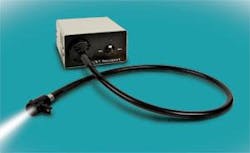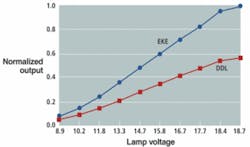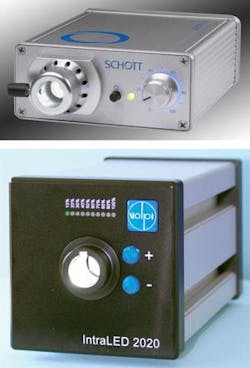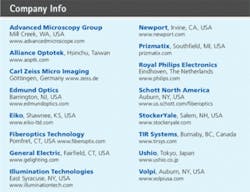Light Pipes
With the emergence of high-brightness LEDs, manufacturers are developing LED-based fiberoptic illumination sources
With their often-touted advantages of low power consumption, long lifetime, and fast strobing capability, today’s LED-based illumination systems use red, green, blue, and white LEDs independently or in combination to generate light. However, despite these advantages, the luminous output of halogen incandescent lamp-based light sources still far exceeds any LED lamps, making them the method of choice for fiberoptic illumination.
In choosing lighting for a machine-vision system, several factors must be considered. These include its luminous output and the efficiency of the light source, correlated color temperature (CCT), and color rendering index (CRI). While the luminous output is often specified in lumens, the efficiency of a light source is specified in lumens/watt. Obviously, the higher this figure the more efficient the light source will be.
Since light sources such as incandescent halogen lamps emit light due to the temperature of the source, the light emitted is similar to that emitted from a blackbody. Although it could be specified as a simple color temperature, it is more commonly described in terms of a CCT, the color temperature of a blackbody radiator that most closely matches the light from the lamp. These color temperatures range from approximately 1800 K to 16000 K, with tungsten lamps providing 2200 K to 3300 K and typical warm daylight 5000 K.
While the CCT is useful in specifying the color of the lamp, the CRI shows how the light source can be used to reproduce the colors of various objects compared with natural light sources. The CRI ranges from 0 to 100, where high-pressure sodium lamps may typically provide a CRI of 24, cool white fluorescent lamps a CRI of 64, and metal halide bulbs a CRI of 93. Since incandescent light sources such as halogen lamps model blackbody radiators, they are often rated with a CRI of 100.
Most manufacturers of fiberoptic illumination sources offer products based around multifaceted reflector (MR) lamps that use halogen light sources. These are known as MR16 bulbs, because the maximum 2-in. diameter of the lamp is specified in eighths of an inch. The most commonly used lamps are rated at 150 W and 20–21 V, with ANSI codes DDL, EKE, and EJA. These codes identify the power rating, bulb shape, and beam angle and allow a variety of manufacturers to produce standard replacement lamps.
Specifications for these bulbs are rated with useful lifetimes of 500, 200, and 40 hours and intensity values of 35, 80, and 354 lumens, respectively. With CCTs of 3150 K, 3200 K, and 3350 K, these lamps are available from a number of vendors including General Electric, Ushio, and Eiko.
Light and life
“If a fiber bundle (typically 1/4 to 1/2 in. in diameter) is held at the focal point of a 150-W, EKE halogen bulb, the total luminous flux incident on a surface per unit area in the bundle is about 1M lux—at least one order of magnitude greater than direct sunlight at the surface of Earth,” says Ivan Maksymyk of StockerYale.
Of course, this is the highest possible illuminance available and will be degraded by the type and length of the optically coupled fiber. “We measured the light output from some halogen light sources that use EKE lamps,” says Steve Giamundo of Fiberoptics Technology. “Light output was focused on a 0.5-in.-diameter fiber bundle, traveled 1 m through the bundle, and emitted about 22,000 lux one foot away from the bundle.”
“Although the rated lifetimes are given as 200 hours for the EKE and 500 hours for the DDL, the EKE has more than five times the lifetime in fiberoptic applications, since the EKE has much more efficient coupling to standard fiberoptic assemblies,” says Mike Muehlemann, president of Illumination Technologies. “Many customers switch to the DDL with the false hope of increasing lamp lifetime. For a given standard fiberoptic assembly, the amount of light passing through the fiber and onto the working plane is, on average, 72% higher for the EKE versus the DDL” (see Fig. 1).
“While this is true for 0.5-in.-diameter lightguides, both EKE and DDL lamps will perform equally as well once the active fiber area exceeds this value,” says Giamundo. “Most, if not all, fiberoptic light sources output 21 V, and since DDL lamps operate from 20.5 V, the lamp is overdriven and will never achieve its full rated life if it is driven at 100% voltage. If the DDL lamp is driven at full power, is better to use an EKE lamp, as long as the fiber diameter is 0.5 in. or less.”
Trying to compete
Lamp lifetime is one of the main reasons companies are now looking to replace these bulbs with high-brightness LEDs. However, building illumination systems to replace halogen lamps is not an easy task. First, the power supplies required are not the standard 150-W, 20–21-V supplies used to drive ANSI-standard halogen bulbs. Second, without using a sophisticated optical design consisting of multiple LED dies, the CRI of such lamps will not be close to the CRI of 100 obtained with metal halide lamps. Last, the illuminance created by these lamps is smaller than that for halogen bulbs, despite the fact that CCT as specified by LED manufacturers may be equivalent.
“To achieve a reasonable range of CCTs of 3000 K to 6500 K, it is necessary to select warm white and cool white LEDs with CCTs at the extremes of the desired range,” says Marc Salsbury of TIR Systems, recently acquired by Royal Philips Electronics. “Even if the LEDs are carefully matched to have exactly the chromaticity of the blackbody locus at these temperatures, blending their light to generate white light with intermediate CCT will not produce a true white light.
“On the positive side,” says Salsbury, “cool white LEDs typically have CRIs of 70, while warm white LEDs have CRIs in excess of 85. White-light LED clusters with tunable color temperatures can be implemented with warm white, green, and blue LEDs. In this approach, only minimal amounts of green and blue light are needed to shift the color temperature to 6500 K or higher and obtain a CRI of 91.”
For their MR16 lamps, most lamp manufacturers specify beam angle and center beam candle power—the luminous intensity at the center of the beam. For example, the LED-based MR-16 GU10 from Alliance Optotek produces 600 lux (at 1.64 ft with a 60o beam angle), more than an order of magnitude less than the equivalent halogen-based lamp. However, it is not just the luminous intensity that needs to be increased in LED lamps. Even if multiple LEDs could produce similar light output to equivalent halogen bulbs, they are point light sources, and effective coupling to fiberoptic bundles is more difficult.
LED illumination
These factors have not stopped manufacturers keen to be the first to introduce LED-based lighting systems. Last year, Edmund Optics became the first to offer such a product—the Chameleos—that used a patented array of LEDs that allowed the color spectral output to be automatically adjusted (see Vision Systems Design, November 2007, p. D10). Since then, due to customer feedback and specific market demands, the company has withdrawn the unit from the market and is looking to license the core optical technology.
Recently, a number of other companies have entered the market with a range of LED-based illumination fiberoptics products (see Fig. 2). These include Advanced Microscopy Group, Carl Zeiss Micro Imaging, Newport, Prizmatix, Schott North America, and Volpi. While companies such as Volpi appear to be pursuing the machine-vision market, Newport, Zeiss, Schott, and Prizmatics are offering products tailored to the microscopy market.
In the design of the IntraLED 2020, for example, Volpi has produced an LED light source that features a CCT of 5600 K and uses just 15 W to achieve a light intensity of 3000 lux. This is more than one magnitude less that the luminous output provided by halogen-based units.
Other companies have used the spectral characteristics of LED lamps to address niche markets in microscopy. White-light sources such as those produced from halogen-based illumination systems emit light across the entire spectrum. However, to excite a fluorescent dye, only a small part of the spectrum is required, which, in halogen-based systems is determined by choosing the correct excitation filter. Unless the rest of the undesired light is suppressed efficiently, it will be added to the fluorescence signal and reduce the contrast of the image. Since LEDs only emit a narrow spectral band, there will be less undesirable light, and the contrast of captured images will increase.
One impressive LED design that targets this market is offered by Zeiss. Known as the Colibri System, it allows the user to choose from ten LEDs ranging from UV through to dark red and to combine the spectral output of four individual modules at once (see Fig. 3). Using the company’s AxioVision software, the desired intensity in percentage steps for each individual LED can be set using a control panel, and the illumination intensity can be adjusted individually. Because each individual LED module uses automatic component recognition, any additions or changes to an illumination setup are automatically detected by Colibri.
Schott has also recognized the usefulness of LED-based light sources and offers many that incorporate red, white, green, blue, and UV LEDs. With a spectral light output of 130 lumens, the white-light unit has a CCT of 6000 K and can be used with all of the company’s COLDVision lightguides. According to Dominic Bucci, business manager of the Industrial Products Division of Schott, this is still more than an order of magnitude less than the luminous intensity required for industrial machine-vision applications.
null





